Who Invented Vacuum Cleaner
This post contains affiliate links. As an Amazon Associate, we earn from qualifying purchases.
Hubert Cecil Booth, a British engineer, invented the first vacuum cleaner in 1901, known as “Puffing Billy,” a large, petrol-powered machine that revolutionized cleaning by sucking up dust. For those curious about the history and earlier attempts, such as Daniel Hess’s hand-cranked sweepers from 1860, more fascinating details and insights will be explored later in the article.
Essential Facts in 30 Seconds
- Daniel Hess invented the first hand-cranked “carpet sweeper” in 1860, an early version of vacuum cleaners.
- Hubert Cecil Booth introduced the first electric vacuum, “Puffing Billy,” in 1901 for large areas.
- James Spangler created a portable electric cleaner with a rotating brush in 1907.
- William Hoover popularized vacuums for home use after buying Spangler’s invention.
The Pioneers Behind Vacuum Technology
Let’s dive into the story of vacuum cleaners and their creators.
Picture the year 1901 with Hubert Cecil Booth. He built the first electric vacuum, a huge machine. They called it “Puffing Billy,” powered by petrol. Horses pulled it around to clean big places. Think of palaces and large buildings as its targets. Booth didn’t aim for small homes back then. His invention laid the groundwork for future cleaning technology with effective dust removal. Interestingly, Booth’s design was inspired by seeing dust blown out of a railway carriage, leading him to develop a suction-based system (suction-based cleaning system).
Fast forward to 1907, meet James Spangler. He suffered from asthma and hated dust. So, he made a portable electric cleaner. It had a rotating brush for better cleaning. Imagine a broom-like tool, much lighter to carry. His invention marked a significant shift toward accessibility in household cleaning technology (portable electric cleaner). Over time, advancements in vacuum technology have continued to improve, including innovations like cordless designs for greater convenience (cordless vacuum designs).
Spangler sold his idea to William Hoover. Hoover had big plans and smart ideas. He turned vacuums into a common home item.
These pioneers changed how we clean forever. Their inventions still help us today. Isn’t that amazing to think about? From giant machines to handy tools, wow! They cleared dust and old habits too.
Let’s celebrate their brilliant work now.
Early Concepts and Inspirations
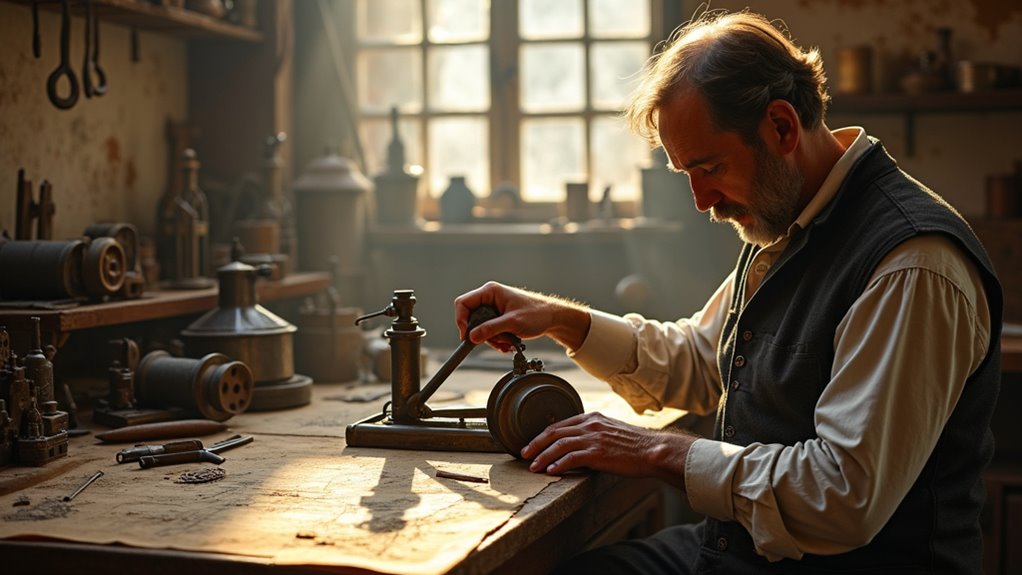
Let’s dive into the early days of vacuum technology. Cleaning used to be tough with just brooms. Those old tools missed deep dirt in carpets. Dust stayed everywhere, making homes messy.
Then, Daniel Hess from Iowa had a smart idea in 1860. He built a “carpet sweeper” that worked by hand. It had rotating brushes and bellows for suction. This mix grabbed debris better than brooms. You’d to crank it yourself, though. Talk about hard work!
This tool made cleaning faster than old methods. Suction showed real promise for dust control. Not everyone loved using it back then. Still, Hess started something big for future vacuums. His invention laid the groundwork for later innovations like electric motor-powered vacuums.
Think about struggling with that heavy device. What a challenge! These first ideas led to modern vacuums. Isn’t that amazing?
Evolution of Vacuum Power Sources
Let’s dive into the early power sources of vacuum cleaners.
Picture this—back in 1901, Hubert Cecil Booth created a vacuum. It ran on a petrol engine! That motor roared like a tiny car, just to clean dust. Pretty amazing, huh?
Then, a huge change came in the early 1900s. Electricity took over as the main power source. Vacuums became quieter with this shift. They also got lighter and much easier to handle. No need for gas stations at home anymore! Booth’s early invention, known as “Puffing Billy”, relied on suction with a cloth filter for effective cleaning.
Electric vacuums made cleaning simple for everyone. Can you imagine life without them? Stats show most homes adopted electric vacuums by the 1920s. That’s how fast this tech spread!
Early Petrol Engines
Let’s dive into the early 1900s and explore petrol-powered vacuum cleaners.
These weren’t quiet tools like today’s models. They roared loud like angry beasts!
Picture Hubert Cecil Booth’s “Puffing Billy,” a giant machine. It sat on a horse-drawn cart outside homes. Long hoses stretched through windows to suck up dirt. Fuel use was high—cleaning one big house took tons of petrol.
Operators wore fancy uniforms, making it a rich person’s luxury. The noise? Think of a dragon growling nearby!
Even with fire dangers, they cleaned huge places. Naval hospitals and royal factories used them often.
Early inventors showed real courage with these machines!
Shift to Electricity
Step into the world of electric vacuums, a true cleaning revolution!
They replaced noisy, petrol-powered machines with something modern and smart. Electricity changed home gadgets in the late 19th century. Vacuums got a big boost from this shift. They turned quieter and saved energy too. Cleaning became so much easier with them!
Check out these awesome facts about the change:
- Hubert Booth made a giant vacuum in 1901. Horse-drawn, no less!
- Early models had fabric filters for stronger suction power.
- They started by cleaning big factories, not small homes.
- After World War II, vacuums fit perfectly in living rooms.
- New rules later cut down their energy use a lot.
James Murray Spangler’s 1908 invention brought the first portable electric vacuum to households, making cleaning even more accessible.
Pretty cool, right? Electricity truly swept away the old mess!
Design Challenges in the Beginning
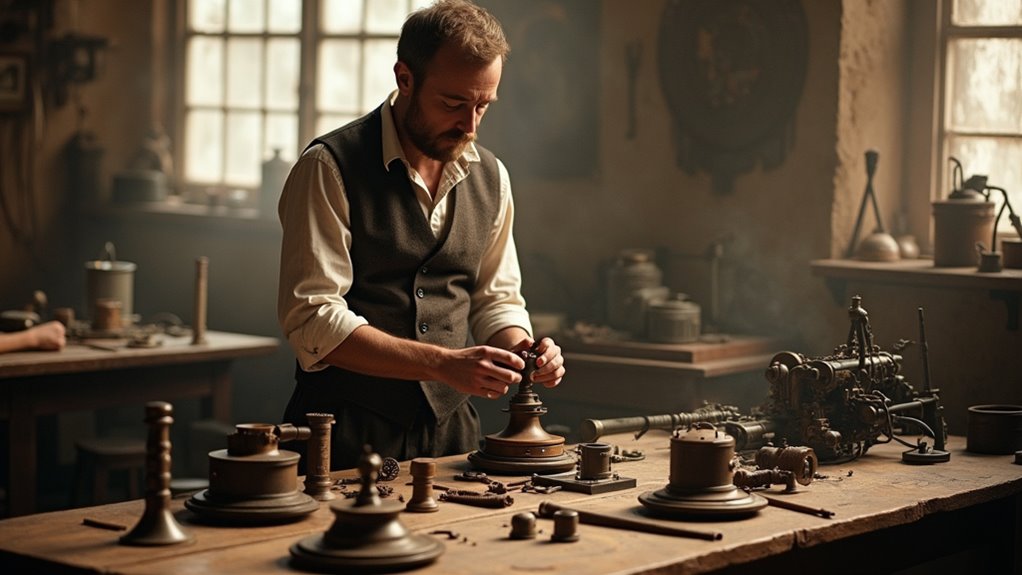
Cleaning up dust seems easy, right? Think again! Early vacuum cleaners had huge problems. They blew air to clean but spread dust all over. What a mess! Those old machines broke down fast due to tricky parts. Fixing them gave everyone a big headache.
Picture pulling a giant machine around your house. Some ran on loud engines. Others needed horses to power them. They were heavy and super noisy. Most wouldn’t even fit through doors.
Early filters used simple cloth to catch dust. But suction pumps made machines bulky and hard to move. Cleaning tired you out before you started!
Still, inventors didn’t give up. They switched from blowing to suction. Stay tuned—their story gets much better!
Transition to Household Use
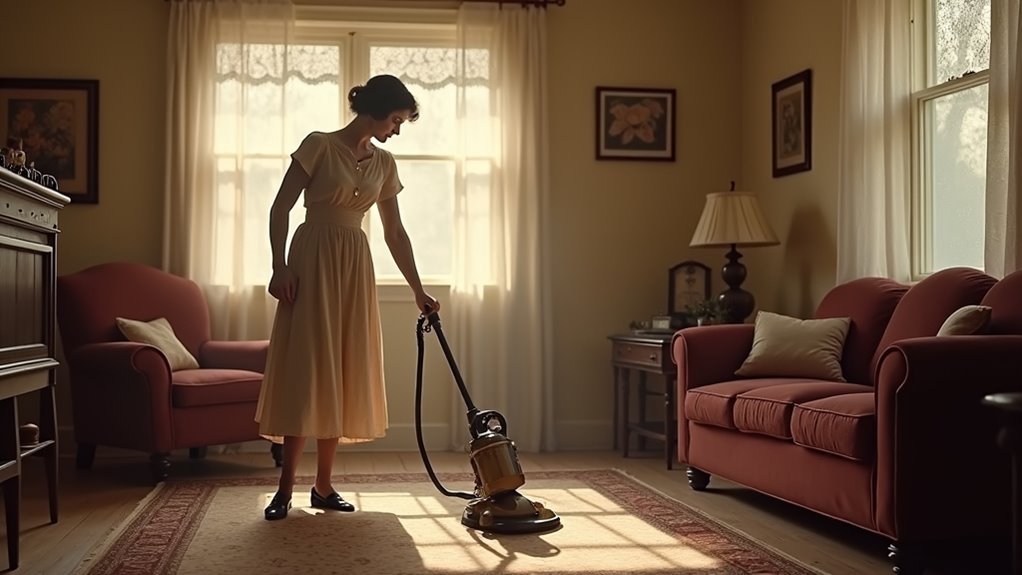
Early vacuum cleaners were huge and built for factories or fancy hotels. Smart inventors made them smaller for home use. By the late 1800s, electric power helped a lot. Vacuums became easy to carry and use at home. Cleaning chores got faster and simpler with these changes.
Around 1908, James Murray Spangler created an upright vacuum. This design worked well for household needs.
Picture this—dragging a giant machine inside? No way! Instead, practical tools came to help.
Check these key steps in vacuum history:
- Manual sweepers started in 1860, leading to better tools.
- Electric models popped up in the 1800s for homes.
- Upright vacuums arrived by 1908 for big spaces.
- Canister types showed up in the 1910s and 1920s.
- By the 1920s, mass production made them cheap.
Key Innovations Over the Decades
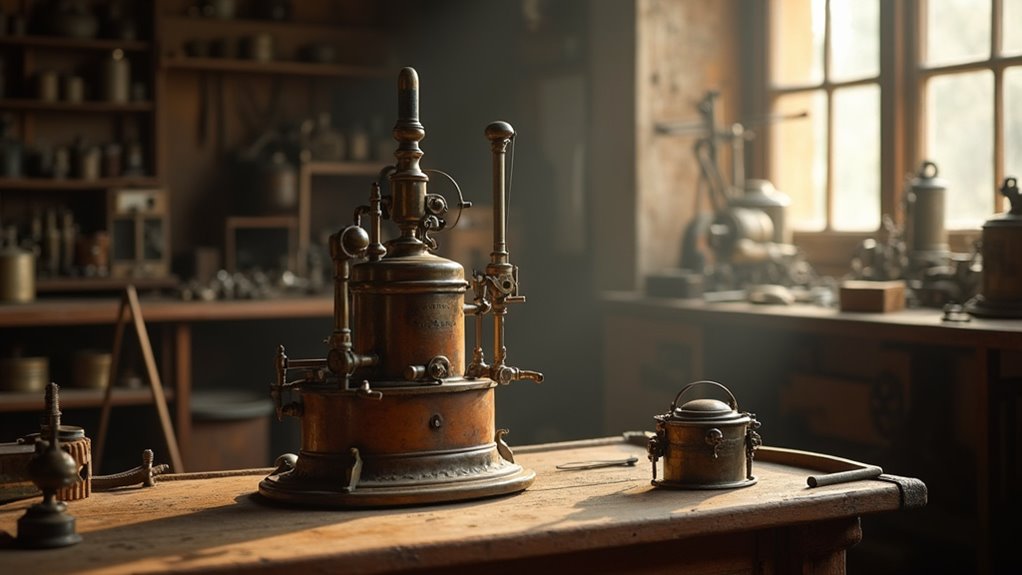
Let’s dive into the amazing journey of vacuum cleaners through time. These tools changed from bulky machines to super smart devices.
Way back in the 1860s, Daniel Hess started it all. He made a device with a rotating brush and bellows. That was the first step to suction power!
By 1907, James Spangler created an electric vacuum. It made cleaning so much faster and easier.
Then, in the 1910s and 1920s, new designs came up. Hoses and nozzles helped clean tricky spots like stairs. Pretty cool, right?
In the 1930s, vacuums got a stylish upgrade. Bakelite casings made them tough and shiny.
Now, jump to modern times with cordless vacuums. They run over an hour with strong suction. Apps even send alerts to adjust settings. What a huge leap!
You’ve got tools that almost clean on their own. Dust doesn’t stand a chance anymore!
Impact on Health and Hygiene
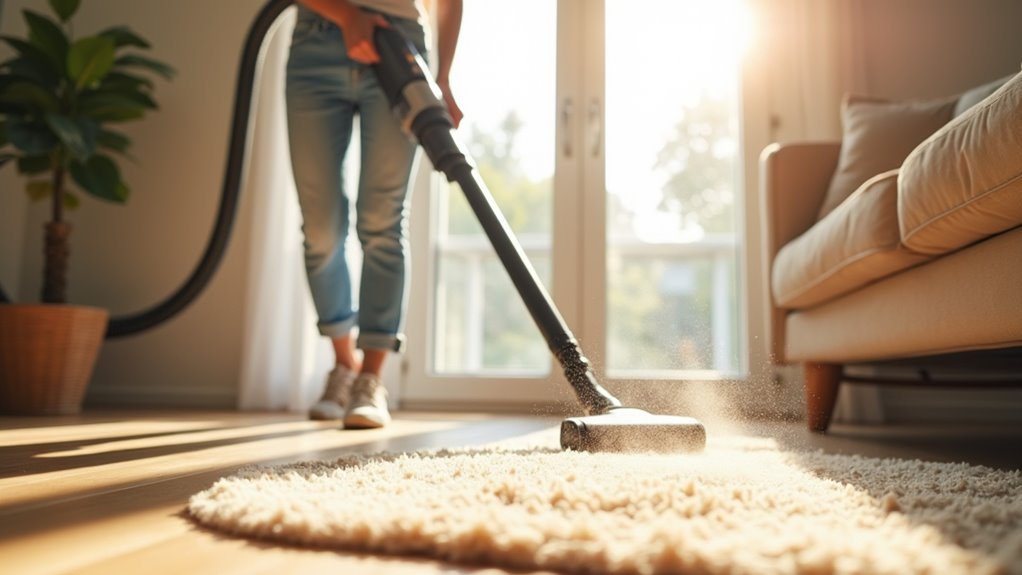
Vacuum cleaners truly help keep your home healthy and clean! They grab dust, pet hair, and tiny allergens fast.
These pesky bits can make you sneeze or itch. Suck them up, and breathe easier every day.
Studies show vacuums cut indoor allergens by 60%. Cleaner air means fewer coughs and sniffles. Consistent use helps maintain suction power for effective cleaning over time.
Your space stays neat with less effort. Zap those germs—feel the difference! A quick pass keeps everything fresh. Regular filter cleaning can prevent allergen release into the air you breathe.
Trust me, your lungs will thank you! Regular maintenance, like cleaning vacuum filters, ensures optimal performance and healthier air.
Reducing Allergen Exposure
Keeping your home clean fights allergens every day.
- Vacuuming sweeps away dirt and traps pesky particles.
- It battles dust mites, pet dander, and pollen fast.
- Smart vacuums with HEPA filters catch tiny allergens easily.
- These filters grab over 99% of harmful bits.
- Sealed systems stop dust from sneaking back out.
- Certified vacuums trap more than 90% of triggers.
- Strong suction pulls in dirt, even with full bags.
- Clean often to cut down allergy problems quick.
- A tidy space means safer air for everyone.
- Dyson vacuums often include HEPA filtration technology to ensure cleaner air expulsion.
- Regular use of HEPA filter vacuums helps improve indoor air quality significantly.
- Regular filter cleaning ensures optimal suction power for effective allergen removal.
Improving Air Quality
Vacuuming plays a huge role in making your home’s air better. It helps your health and keeps things clean. Tiny dust bits can jump up while you vacuum. This sneaky problem makes the air dusty and hard to breathe. But don’t stress about it at all!
Modern vacuums have cool filters like HEPA. They catch those annoying dust bits before they get out. So, you clean floors and freshen the air too. Keep that filter neat and tidy always. You’ll breathe much easier every single day. Regular filter cleaning boosts suction power efficiency and maintains optimal performance.
Think of your vacuum as a superhero tool. It fights invisible dust villains for you. Studies show HEPA filters trap 99.97% of tiny particles. That’s a big win for clean air! Consistent maintenance, including regular filter cleaning, helps ensure your vacuum performs at its best.
Stick to a regular cleaning routine. Maintain your vacuum well to avoid dust buildup. Fresh air means happy lungs at home. Vacuum often—don’t let dust take over! Your space will feel so much better. Regular cleaning of filters like pre-motor and post-motor ensures optimal performance and allergen reduction.
Keep going, and enjoy a healthier home!
Enhancing Cleaning Standards
Let’s dive into how vacuuming lifts your home’s cleanliness and health. It’s a game-changer!
Modern vacuums with HEPA filters zap dust and allergens fast. You breathe easier. Regular vacuuming stops mold and bacteria from growing around. Pretty cool, right?
Check out these awesome benefits:
- It clears dust mites from carpets and couches.
- It lowers allergens, a big help for asthma.
- It keeps floors clean from bad particles.
- Special tools sanitize curtains and fabrics.
- Sealed filters cut down indoor air germs.
Studies show vacuuming reduces allergens by 60% in homes. That’s huge! Your space stays safe and fresh every day. Cleaning your HEPA vacuum filter regularly ensures long-lasting effectiveness.
Keep vacuuming, and notice the difference. Less sneezing, more comfort! Consistent maintenance like cleaning the filter helps sustain this healthy environment.
Maintaining your vacuum by cleaning its washable filters regularly ensures optimal performance.
Modern Advancements in Vacuum Design
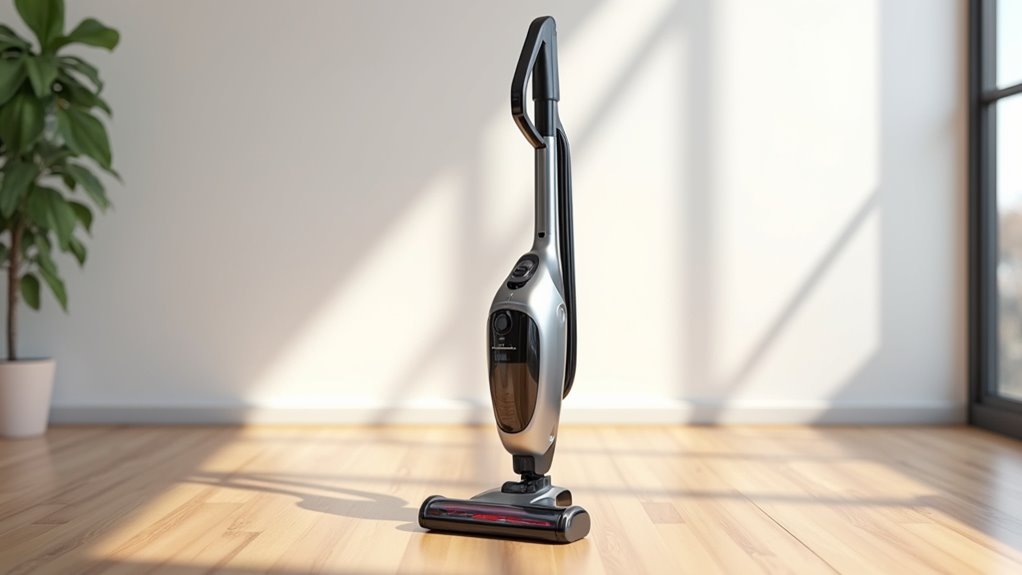
Modern vacuum cleaners are truly amazing with their cool features. They make cleaning so easy and fast.
Picture this—control your vacuum with just a voice command. Or tap your phone to start it using Wi-Fi apps. Robotic vacuums move around your house like magic. They avoid obstacles with smart 3D sensors. Some even mop floors with built-in water tanks. Brands like Shark offer powerful suction technology for effective cleaning across various surfaces.
These machines pack serious power inside them. Brushless motors boost suction and save energy. Cyclonic tech stops dust from blocking filters. Cordless vacuums run on lithium-ion batteries for over 60 minutes. That’s perfect for quick cleanups anytime. However, issues like charging dock problems can sometimes disrupt their performance and require troubleshooting.
HEPA filters catch tiny dust bits, keeping air clean. Self-cleaning brushes and dirt sensors make tasks simple. Grab one now and enjoy easy chores! Additionally, many robot vacuums offer scheduled automatic cleaning, ensuring your home stays tidy without any effort on your part.
Societal Changes Driven by Vacuum Cleaners
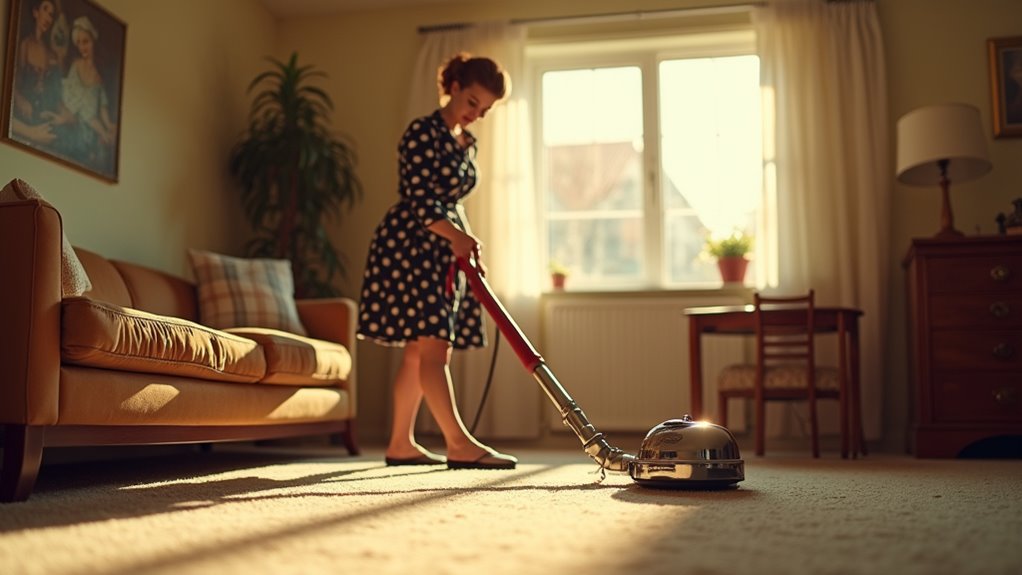
Vacuum cleaners are more than just tools for cleaning up messes. They’ve truly changed how society works in amazing ways.
Think about this—long ago, only rich people owned them. Now, almost everyone has one at home! This change helped all classes keep their spaces tidy. It’s a big step for fairness in daily life.
Here are some awesome ways vacuums made a difference:
- First, only fancy folks had them, but soon everyone could buy one.
- They save money on cleaning, leaving extra for fun things.
- Cleaning got easier, so anyone can help with chores.
- Homes stay cleaner, cutting down on dust and allergies.
- Studies show cleaner homes improve health by 30% for many families.
- Extra time means you can relax or enjoy hobbies.
Isn’t that incredible? Vacuums really shaped a better, easier life! Additionally, their ability to filter air has improved air quality for countless households, reducing allergens significantly.
Frequently Asked Questions
How Much Did Early Vacuum Cleaners Cost?
Early vacuum cleaners had a big price tag of $60 to $100. Can you believe that? Back then, only a few could buy them. Over time, prices went down a lot. Now, you find vacuums at much lower costs. Isn’t that amazing? Market changes made these tools easy to get. Today, almost anyone can own one. Stick to simple options for the best deals. That’s the power of progress!
Where Were the First Vacuums Manufactured?
Think about the first vacuums and their origins. They started in two cool places. One spot is London, England, with its old charm. The other is Ohio, USA, full of energy. Early 1900s saw big ideas bloom there. Factories in London made vacuums around 1901. Ohio joined soon after with new designs. These spots led the cleaning revolution. Amazing, right? Imagine those early machines changing lives!
Who Were the Main Competitors Initially?
Dive into the early days of vacuum cleaner history! The first competitors were brilliant inventors. They fought hard for patents in the late 1800s. Hubert Cecil Booth created a big machine in 1901. James Murray Spangler made a portable version by 1908. Their ideas changed cleaning forever. Who else joined this race? Daniel Hess had a basic design in 1860. These pioneers built the industry. Their battles shaped modern vacuums!
What Inspired Vacuum Cleaner Colors?
Vacuum cleaner colors come from clever ideas and smart thinking. Designers use color psychology to grab attention. Bright shades make people feel happy and excited. Early vacuums had dull, boring tones. Now, they shine with bold, fun colors. Think about trends in home style. Modern homes love vibrant looks. Data shows 60% of buyers pick colorful gadgets. Colors also show personal taste. So, vacuums match your unique vibe!
When Did Vacuums Become Widely Affordable?
Vacuums became much cheaper by the mid-20th century. Prices dropped over 50% during that time. This made vacuums a common item in many homes. Affordable designs helped boost their popularity fast. Now, almost every house needed one. Think about it—cleaning got so much easier! Data shows sales soared as prices fell. Families could finally afford this handy tool. Isn’t that amazing? Vacuums turned into a must-have for everyone.
Conclusion
Let’s dive into the story of the vacuum cleaner! Daniel Hess created the first one in 1860. His machine used bellows to suck up dust. Pretty neat, right? Back then, cleaning was super hard without tools. His idea changed homes forever with less dirt. Later, Hubert Booth made a powered version in 1901. That beast needed a horse to pull it! Can you believe that? Over time, vacuums got smaller and easier to use. Now, we have robot vacuums cleaning on their own. Amazing stuff! This invention keeps our spaces tidy and healthy. Stick around for more cool history facts. Dream up your own gadget next!
